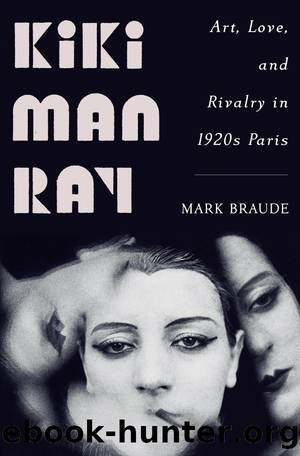Kiki Man Ray by Mark Braude

Author:Mark Braude [Braude, Mark]
Language: eng
Format: epub
ISBN: 9781324006022
Publisher: Norton
Published: 2022-06-29T00:00:00+00:00
16
KIKI WITH AFRICAN MASK
Early 1926. There are three of them in the room: Kiki, Man Ray, and George Sakier, recently hired as junior art director for Vogue, whose French edition had launched six years earlier. Sakierâs family had lived near the Radnitzkys in Brooklyn. He used to play tennis with Man Rayâs youngest sister, Elsie. Heâd moved to Paris not long after Man Ray, longing to become a great painter or designer.
They have no directive to peg the image to any specific cultural event, nor to display any clothing from one of the magazineâs advertisers. Theyâre free to experiment. Sakier has brought a mask of polished wood, as tall as a human head but half the width. Skilled carvers of the Baule peoples of the Ivory Coast make similar-looking masks to praise a specific womanâs beauty or dancing skill, or as a commission to honor a particular woman. Dancers donned such masks for performances, but only if the maskâs âdouble,â the woman portrayed, was present to witness the masquerade. Maybe Sakierâs mask is an original imported from the Ivory Coast, at that time a French colony. More likely it was produced with the tourist trade in mind, an inexpensive mass-made replica of some original piece or newly created to mimic the style of Baule portraits masks. (The mask they used for the photo has been lost for decades.)
For a fashion editor, photographer, and model to come up with the idea of presenting a European woman as modern and alluring through her interaction with some aspect of African culture is hardly a radical move by this time in Paris. Industrial capitalism has led people astray, and Western civilization is in decline, goes the local logic, and white modern artists must look far beyond their homes for vital inspiration. There are so many precedents from which Man Ray, Kiki, and Sakier may be drawing: Paul Gauguinâs fever dreams of Brittany and Tahiti; Rousseauâs jungle scenes (conjured by a man who never left France); Picassoâs Demoiselles dâAvignon. Critics, collectors, and other artists in their circle have started to amass collections of African objects. The influential dealer and critic Paul Guillaume writes in his magazine, Les arts de Paris, about âThe Discovery and Appreciation of Primitive Negro Sculpture,â which in his view has revitalized the spirit of European art, until then âmenaced by extinction.â
But if primitivism is by 1926 a well-worn concept, Kiki, Man Ray, and Sakier are taking it into a new realm. Rather than providing the fodder for a painting or an object, theyâre channeling such thinking into a photograph, a recording of reality, if staged as a Surrealist juxtaposition: âcivilizedâ white woman and âprimitiveâ Black mask.
To the three of them, the mask may be no more than a piece of useful ephemera to offer up to the cameraâs insatiable eye. Maybe they see it as a flea market find, no different from an obscure jazz record discovered at the back of a crate, or a Eugène Atget print of a desolate
Download
This site does not store any files on its server. We only index and link to content provided by other sites. Please contact the content providers to delete copyright contents if any and email us, we'll remove relevant links or contents immediately.
| Belgium | France |
| Germany | Great Britain |
| Greenland | Italy |
| Netherlands | Romania |
| Scandinavia |
Room 212 by Kate Stewart(5077)
The Crown by Robert Lacey(4766)
Endurance: Shackleton's Incredible Voyage by Alfred Lansing(4724)
The Iron Duke by The Iron Duke(4325)
The Rape of Nanking by Iris Chang(4173)
Joan of Arc by Mary Gordon(4058)
Killing England by Bill O'Reilly(3974)
Say Nothing by Patrick Radden Keefe(3940)
I'll Give You the Sun by Jandy Nelson(3399)
Shadow of Night by Deborah Harkness(3327)
Hitler's Monsters by Eric Kurlander(3293)
Mary, Queen of Scots, and the Murder of Lord Darnley by Alison Weir(3177)
Blood and Sand by Alex Von Tunzelmann(3170)
Eleanor & Park by Rainbow Rowell(3120)
Darkest Hour by Anthony McCarten(3100)
Margaret Thatcher: The Autobiography by Thatcher Margaret(3053)
Book of Life by Deborah Harkness(2895)
Red Famine: Stalin's War on Ukraine by Anne Applebaum(2895)
The One Memory of Flora Banks by Emily Barr(2836)
